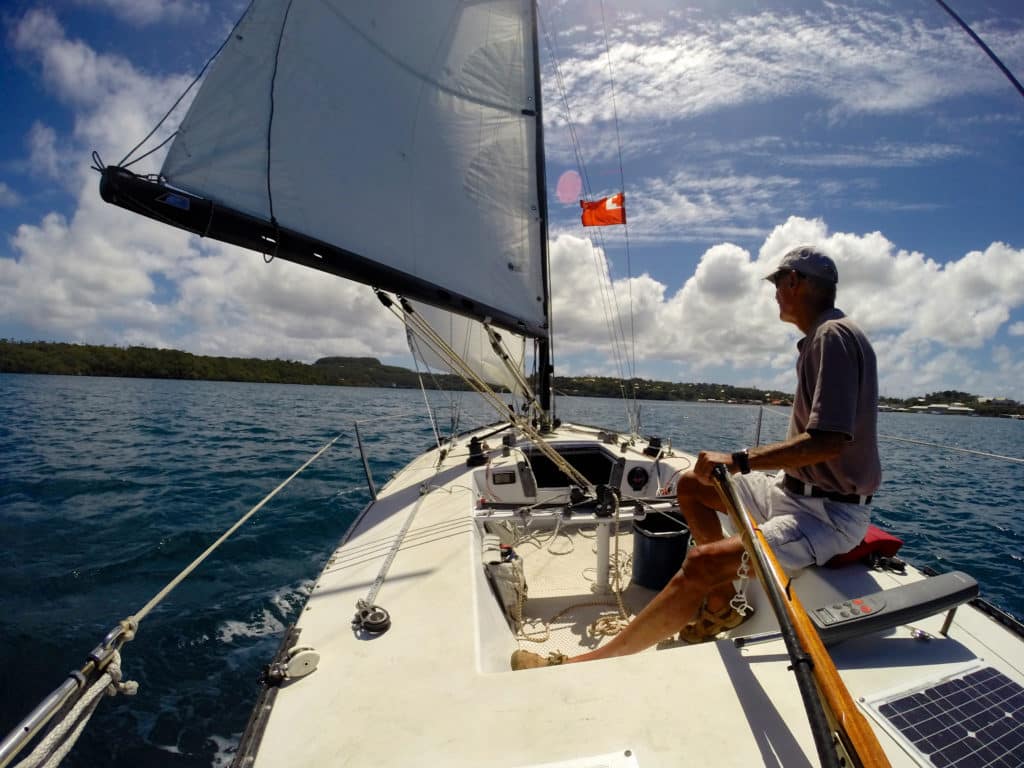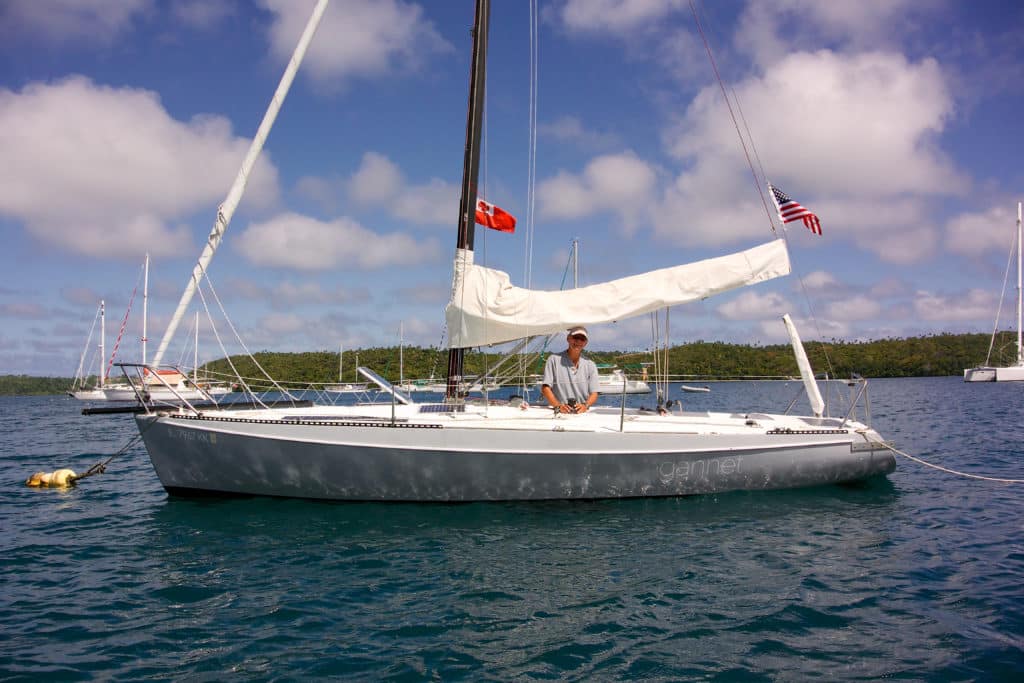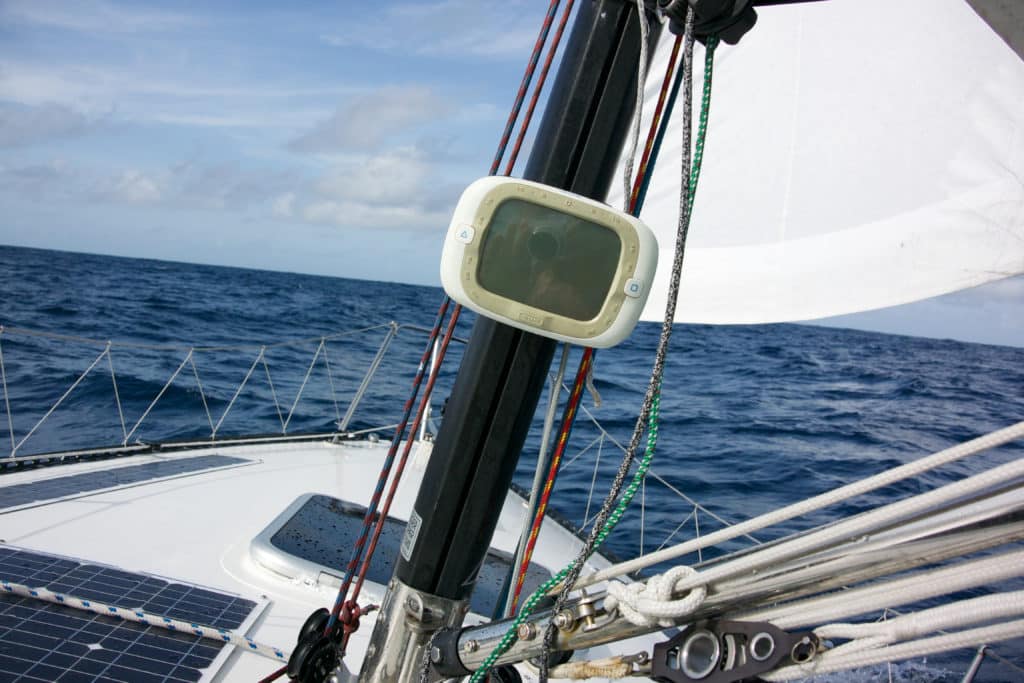
As soon as I opened the companionway, I knew we had too much sail up. Gannet, my ultralight Moore 24, is a thin and often permeable membrane, but the wind was much stronger than I had realized down below: gale-force. Gannet was being overwhelmed.
I hesitated only a moment before deciding to let the main halyard go and continue under furled jib alone. Running backstays had been installed in Honolulu for just that purpose. The windward one was already in place, as it usually is on passages when I expect the wind to be on the same side of the boat for an extended period. The fully battened main slid down the Tides Marine track. I grabbed a line from a cockpit sheet bag, crawled the few feet to the mast, and, hanging on with one hand as 12- to 15-foot waves crashed over us, crudely lashed the sail to the boom. Back in the cockpit, I felt that even the remaining scrap of jib was too much, and furled it down to T-shirt size.
My last tillerpilot had died the night before, so Gannet was sailing on a close reach with the helm tied down. The first tillerpilot had lasted 4,000 miles; in the last 2,400 miles, five had failed, including one that had been repaired and failed twice. But they had lasted long enough to make it possible that we would make Opua, New Zealand, on this day, after what had been a three-act passage from Neiafu, Tonga.
The first act was fine sailing, with Gannet covering half the 1,200 miles between ports in four days.
Act 2 was nearly incredible as we sailed through a high-pressure system. For three days, Gannet made only 60 to 70 miles a day, but she did so in zero apparent wind. The days were sunny, the ocean flat and glassy. We might have been in a perfect anchorage, except that the water was miles deep. The little sloop kept moving when almost no other sailboat would have. She was perfectly level, and the tillerpilot almost silent. Our course lay straight. There was nothing to cause the slightest deviation. I stood in the companionway and tried to find the wind. I turned my head from side to side to feel it against my skin. Nothing. I held up my hand. Nothing. No cat’s-paws on the water. At the masthead, the Windex was stuck and useless. Yarn tied to the shrouds hung limp. Gannet sailed on wind imperceptible. And those 200 miles had brought us to within 40 miles of Opua and Act 3: a chance to get in before the northwest gale turned southwest and headed us, effectively shutting the door and keeping us at sea for several more days.
I sail without outside assistance. No sponsors. No shore team. No weather routers. But I do not consider it inconsistent to listen to AM radio as I near land, and so had heard the forecast on Radio New Zealand National, though I know how wind circulates around lows in both hemispheres and would have expected the wind to back anyway, given the barometer.
For that matter, the radio forecast was partially wrong, predicting the west wind would veer northwest the day before. I very much wished it had. Twenty-five knots aft of the beam would have made the ride easier and faster. We would have been in by now. But the wind remained west until well after dark, and Gannet labored south on a course of around 210 degrees true.
After more than 6,000 miles in four months, the little sloop was unraveling. Tillerpilots were dead. The port pipe berth was unusable after the tube had jumped from its socket when Gannet became airborne off a wave and crashed into a trough. One of the two floorboards split along its full length. Insufficient solar charging was caused by at least two of the six panels not functioning. Gannet’s interior had never been wetter, messier or more chaotic. There was not a dry surface anywhere. I had slept the night before in full foul-weather gear, including sea boots, with a sleeping bag as a blanket over me. We really needed to reach port before the cascade became a torrent.
During the night the barometer dropped steeply, and the wind began to veer. Now, finally, it was on the beam, which was good and bad. Gannet wasn’t thrashing into the waves, but she was heeled 30 to 40 degrees, and when waves broke, they rolled her dangerously.
Taking a flotation cushion, I made my way aft to the tiller, untied it, and turned Gannet a bit farther off the wind, bracing myself with my left sea boot on the far side of the cockpit and my right on the post through which the backstay controls run up to the mainsheet traveler bridge.

The overcast sky was dark, solid and low. It seemed to press down on us. I could feel its weight. Rain was falling, colder than the water from the ocean. Although it was 0900, the light was that of pre-dawn. And when darker lines came toward us, which I quickly learned meant a 5- to 10-knot increase in wind and torrential rain, the sky was night, but the surface of the ocean frothed ghostly white.
Gannet was not hard to steer. But I lost vision in my right eye a few years ago, and the waves were coming from starboard, slamming unexpectedly into and over us, literally blindsiding me. These were hard blows, as though we were being punched by a ranked heavyweight. Several knocked me from my seat, lifting my body so that I started to fall forward and down into the sea. I couldn’t possibly leave the helm long enough to go below to get my safety harness, so steering with one knee, I looped a sail tie through the slotted toerail and tied a bowline as a strap for my right wrist.
When the heaviest rain hissed down, I couldn’t see the mast-mounted Velocitek and instead steered by feel, turning Gannet and surfing down waves. She ran beautifully true with no tendency to round up, her bow waves rising above the deck. When visibility returned, I often saw speeds of 11 and 12 knots on the Velocitek, but by then Gannet had slowed, so I don’t know how fast she may have gone. Whatever the number, it is the fastest I’ve ever sailed on a monohull.
I couldn’t see my watch, but after what surely had been an hour, I started looking for land. Cape Wiwiki should have been off the starboard bow, Cape Brett off to the south. But I found only cloud.
I had to twist my neck a long way to see the oncoming waves. Surfing down some, I turned up into others — a split-second decision, often based on how much crest was toppling, sometimes based just on instinct. Still a few caught us, and rolled Gannet almost to 90 degrees, until feet braced, tiller in left hand, sail-tie strap around right wrist, I was standing straight up. As the wave passed, gravity brought Gannet back onto her keel and sat me down.
Beneath my heavy set of foul-weather gear, I was wearing a Polartec fleece and Columbia Omni-Heat pants over my usual shirt and Levis. Despite rain and wave, they were staying dry, and only my exposed hands were cold. My left knee began to feel the constant strain. I tried to ease it and take more weight on my right foot.
The last position I had seen on the iPad Mini I use as my primary chart plotter, before coming on deck, put us 24 miles north of the waypoint, at the entrance to the Bay of Islands. Surely we had covered 7 or 8 miles since then. But still no land.
Another estimated hour passed. We shouldn’t have been more than 10 or 12 miles out — perhaps less. Something should have been visible. And then, off to the south, clouds thinned and Cape Brett materialized, followed by the ridge of land leading west from it. Pleasure flooded over me, as well as water, both at seeing the familiar landmark — I based my last boat, Hawke of Tuonela, in Opua for many years, and the Bay of Islands is one of my favorite places in the world — and because it was the first solid indication that we were likely going to make it in before the wind backed.
A little later, Cape Wiwiki appeared much closer. I began to steer more toward it, wanting to stay to windward as much as possible. I knew that even this close, we could still be in trouble if the wind suddenly backed and we were forced outside Cape Brett.
The low, dark clouds continued to lift, and patches of blue sky appeared ahead. I expected the wind and seas to diminish as we closed the distance to land, but they remained at strength until Cape Wiwiki was abeam.
As we entered the partial shelter of the 9-mile-wide mouth of the bay, I was able to tie down the tiller for a few minutes and duck below to grab a protein bar and take a break.

Gannet’s bilge has a narrow sump. Usually in rough weather, a couple of inches of water a day collects there, and I pump it out with a hand pump that has a hose long enough to go out the companionway and reach overboard. With us now heeled only 10 to 15 degrees, the bilge was overflowing. I got the pump and emptied it. But when I went down later, it was full again, and I began to wonder if I had a problem.
I took the protein bar back on deck just in time to see two of Gannet’s handsome namesake birds glide across our bow.
We still had 14 miles to reach the quarantine dock at Opua.
While the water was smoother, squalls that buried the lee rail continued to hit as we sailed deeper into the bay. I furled and unfurled the jib like a Venetian blind, and alternately hand-steered, tied down the tiller, and hand-steered.
Familiar islands drew closer: a cloud of birds around Bird Rock, white with guano; vivid green hills; exposed brown cliffs falling into the sea; tiny foot-long penguins bobbing on wavelets. I smiled when I saw Paradise Cove, on Urupukapuka Island, where I’ve often anchored, and the lookout platform high on Roberton Island, to which I’ve often hiked.
Not until we made the final dogleg turn beyond the rocky ledge off Tapeka Point, just north of Russell, did the wind moderate. I brought Gannet about and heaved to so I could fit the outboard bracket, Torqeedo, fenders, dock lines and Q flag. Then I turned us again and continued south under sail. I knew the way.
Just north of the car-ferry crossing, within sight of the quarantine dock, the wind died. I furled the jib, turned on the Torqeedo, and lowered the main. Misty rain began to fall as we covered the last 200 yards at dusk.
Opua’s quarantine dock is the easiest to approach of any I know in the world. I had Gannet prepared to tie up port or starboard. With no wind, the tidal current was decisive. It was running out, so I continued forward to tie to port.
Gannet and I were weeks ahead of the herd. The long marina breakwater, of which the northern 200 yards are the quarantine dock, was empty. I turned the Torqeedo tiller arm to neutral, glided the last few feet, stepped off, and tied dock lines. Then I went back aboard to duck into the cabin for a bottle of Laphroaig in which I had saved an inch for this moment. My two crystal glasses had not survived the Pacific, so I poured the single malt into a plastic tumbler, straightened up, and, still wearing foul-weather gear, stood in the companionway indifferent to light rain, which was nothing compared to the total immersions of the morning. The little sloop’s deck came to just above my waist. I looked around at familiar hills and took a sip. Then another.
The date was September 20, 2014. We had sailed from San Diego on May 20: in all, 6,400 miles in four months — or, actually, because of crossing the international date line, a day less than four months.
Passage over.
Ocean crossed.
And, though an American and not a New Zealander, I was home.
The wind backed to the southwest that night and increased to 50 knots, closing the door on a 31-foot cutter that left Neiafu the day after Gannet. She reached Opua a week and a day later.
In the harbor, water continued to trickle into the bilge from odd corners of Gannet’s interior for several days, and then stopped.
After crossing from Opua, New Zealand, to Bundaberg, Australia, this spring, Webb Chiles and Gannet sailed to Darwin, and on July 1, they set out to cross the Indian Ocean, bound for South Africa. You can follow his progress via his tracking page at my.yb.tl/gannet.








